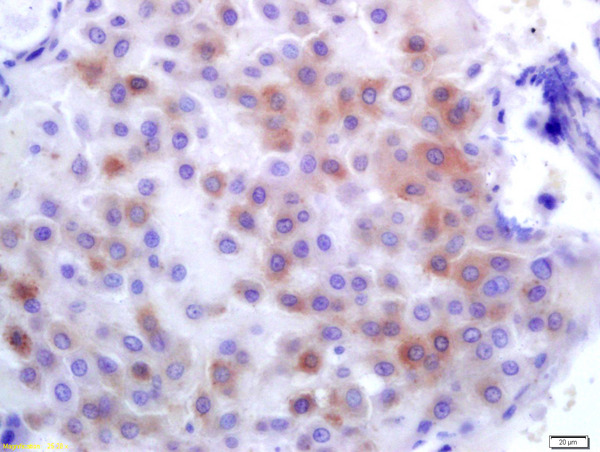PLK1 antibody [N2C2], Internal
GTX104302
ApplicationsImmunoFluorescence, Western Blot, ImmunoCytoChemistry, ImmunoHistoChemistry, ImmunoHistoChemistry Paraffin
Product group Antibodies
TargetPLK1
Overview
- SupplierGeneTex
- Product NamePLK1 antibody [N2C2], Internal
- Delivery Days Customer9
- Application Supplier NoteWB: 1:500-1:3000. ICC/IF: 1:100-1:1000. IHC-P: 1:100-1:1000. *Optimal dilutions/concentrations should be determined by the researcher.Not tested in other applications.
- ApplicationsImmunoFluorescence, Western Blot, ImmunoCytoChemistry, ImmunoHistoChemistry, ImmunoHistoChemistry Paraffin
- CertificationResearch Use Only
- ClonalityPolyclonal
- Concentration1 mg/ml
- ConjugateUnconjugated
- Gene ID5347
- Target namePLK1
- Target descriptionpolo like kinase 1
- Target synonymsPLK, STPK13, serine/threonine-protein kinase PLK1, PLK-1, cell cycle regulated protein kinase, polo (Drosophia)-like kinase, serine/threonine-protein kinase 13
- HostRabbit
- IsotypeIgG
- Protein IDP53350
- Protein NameSerine/threonine-protein kinase PLK1
- Scientific DescriptionSerine/threonine-protein kinase that performs several important functions throughout M phase of the cell cycle, including the regulation of centrosome maturation and spindle assembly, the removal of cohesins from chromosome arms, the inactivation of APC/C inhibitors, and the regulation of mitotic exit and cytokinesis. Required for recovery after DNA damage checkpoint and entry into mitosis. Required for kinetochore localization of BUB1B. Phosphorylates SGOL1. Required for spindle pole localization of isoform 3 of SGOL1 and plays a role in regulating its centriole cohesion function. Phosphorylates BORA, and thereby promotes the degradation of BORA. Contributes to the regulation of AURKA function. Regulates TP53 stability through phosphorylation of TOPORS.
- Storage Instruction-20°C or -80°C,2°C to 8°C
- UNSPSC12352203
References
- Yoshida K, Suzuki S, Yuan H, et al. Public RNA-seq data-based identification and functional analyses reveal that MXRA5 retains proliferative and migratory abilities of dental pulp stem cells. Sci Rep. 2023,13(1):15574. doi: 10.1038/s41598-023-42684-zRead this paper
- Wu YH, Yang Y, Chen CH, et al. Aerobic glycolysis supports hepatitis B virus protein synthesis through interaction between viral surface antigen and pyruvate kinase isoform M2. PLoS Pathog. 2021,17(3):e1008866. doi: 10.1371/journal.ppat.1008866Read this paper
- Hwang G, Sun F, O'Brien M, et al. SMC5/6 is required for the formation of segregation-competent bivalent chromosomes during meiosis I in mouse oocytes. Development. 2017,144(9):1648-1660. doi: 10.1242/dev.145607Read this paper
- Liu LY, Huang WJ, Lin RJ, et al. N-Hydroxycinnamide derivatives of osthole presenting genotoxicity and cytotoxicity against human colon adenocarcinoma cells in vitro and in vivo. Chem Res Toxicol. 2013,26(11):1683-91. doi: 10.1021/tx400271nRead this paper






![IHC-P analysis of squamous cell carcinoma of oropharangeal tissue using GTX01927 PLK1 antibody [MJS1]. Note the intense nuclear and cytoplasmic staining of a proportion of proliferating malignant cells.](https://www.genetex.com/upload/website/prouct_img/normal/GTX01927/GTX01927_20200811_IHC-P_73_w_23053121_314.webp)

![FACS analysis of HEK293T cells transfected with either PLK1 plasmid(Red) or empty vector control plasmid(Blue) using GTX83864 PLK1 antibody [3F12].](https://www.genetex.com/upload/website/prouct_img/normal/GTX83864/GTX83864_204_FACS_w_23061420_168.webp)
![IHC-P analysis of human breast adenocarcinoma tissue using GTX83865 PLK1 antibody [1D4]. Antigen retrieval : Heat-induced epitope retrieval by 10mM citrate buffer, pH6.0, 100oC for 10min.](https://www.genetex.com/upload/website/prouct_img/normal/GTX83865/GTX83865_1943_IHC-P_w_23061420_628.webp)